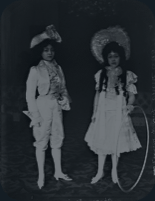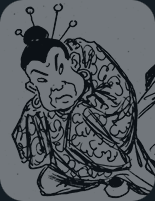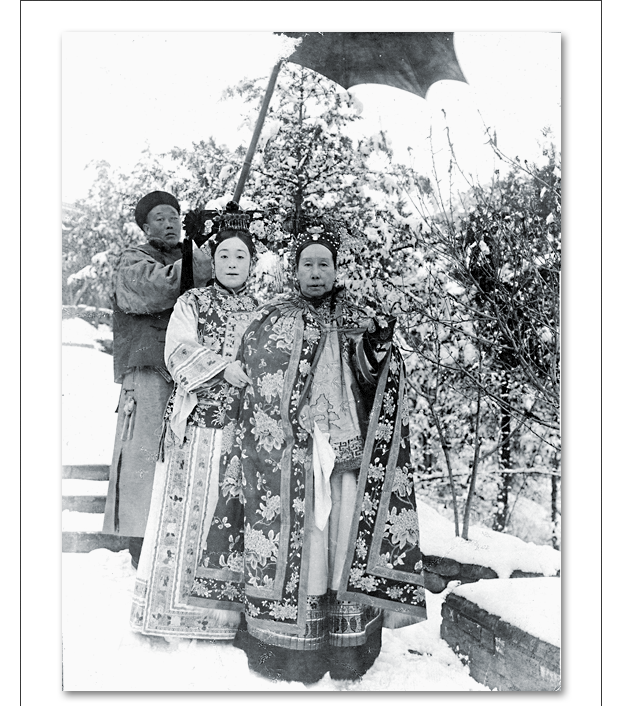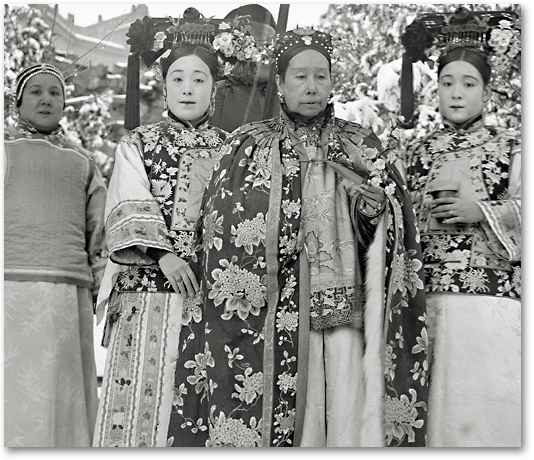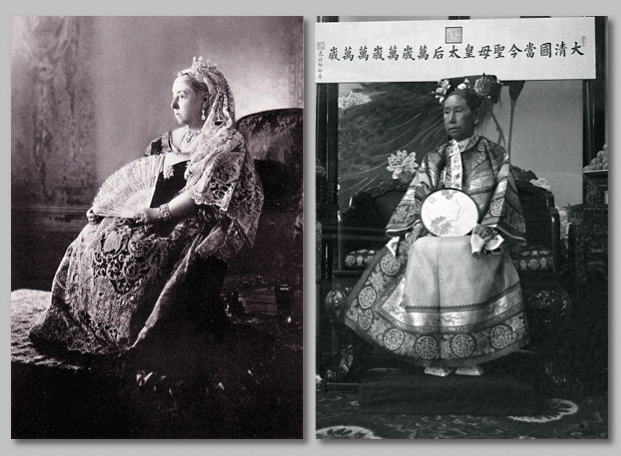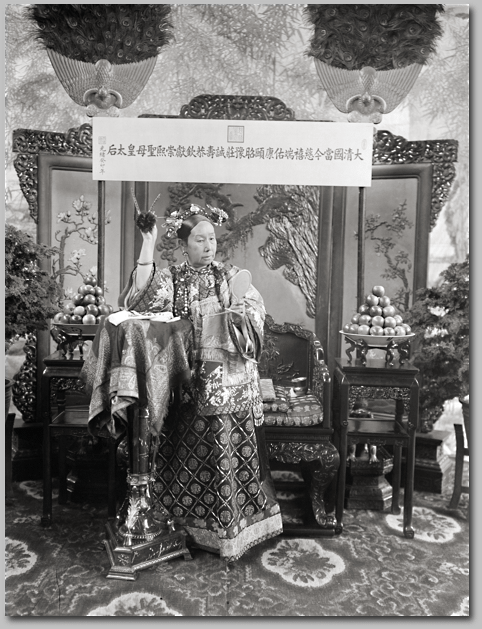 |
| |
Few photographs remain of the Empress Dowager Cixi (1835–1908), China’s notorious head of state during the final decades of the imperial era. Cixi used photographs to model perceptions of her character at the very moment photography was becoming a mass-media vehicle and the Qing dynasty (1644 to 1912) was struggling to survive in a hostile imperialistic world.
Following the virulently anti-foreign Boxer Uprising in 1900, many Chinese as well as foreigners blamed Cixi personally for this disaster. In response, the Qing court initiated measures to reach out to foreign nations through personal diplomacy. Cixi invited members of the foreign legations in Beijing into the palace for luncheons, and appointed a number of Manchus who had been raised overseas to translate and help negotiate the confusing social contacts with Westerners. One of these foreign-raised Manchus was a young man named Xunling (1880–1943), the son of a former ambassador to Tokyo and Paris. Xunling had picked up a passion for photography while overseas. Upon learning this, Cixi engaged him to take a series of individual portraits and elaborate group tableaux that very much reflected her love of theater, as well as her acute awareness that photography could be exploited to change her public image and simultaneously reaffirm her authority.
This Visualizing Cultures unit is based on 36 of Xunling's glass negatives in the collection of the Smithsonian Institution's Freer Gallery of Art and Arthur M. Sackler Gallery Archives. The remainder of Xunling's existing photographs are held by the National Palace Museum in Beijing, or exist only in poor quality commercial reproductions. As such, the Freer set is an important but little known visual record of the advancement of photography as it intruded even into the reclusive inner spaces of the Qing court. There is anecdotal testimony that portraits of Cixi were made by other photographers, but Xunling’s series taken in 1903 and 1904 provides the only surviving photographs of the late Qing dynasty’s most significant political figure.
|
|
Images in this unit, unless otherwise noted, are from the Freer Gallery of Art
and the Arthur M. Sackler Gallery, Smithsonian Institution |
|
 |
| |
PHOTOGRAPHING CIXI
From the 1860s until her death in 1908, the Empress Dowager Cixi (1835–1908) was the dominant political figure in the Qing court. In spite of having begun her career at court as a mid-level concubine, her status as the mother of an emperor, coupled with keen political acumen, ensured her prolonged influence nearly to the end of the Qing dynasty. Cixi’s reign was marked by military and economic setbacks, with only sporadic and short-lived attempts at reform and modernization. The Qing court’s reputation at that time was mostly one of rigid conservatism, corruption, and incompetence. Yet Cixi herself was also an enthusiastic patron of the arts and of theater, and expanded court decorative arts and opera in bold and innovative ways.
The original intention of the Empress Dowager photographs is difficult to assess. By all accounts, Cixi was fascinated with the photographic process, and took an active role in directing the content and composition of each image. It can certainly be argued that the photographs reflect her personal aesthetic preferences for rich, lushly detailed display. Furthermore, a close analysis of the photographs reveals a wealth of visual and textual markers that denote her religious, political, and theatrical interests. Clearly, these photographs must be approached as visual autobiography.
Yet, the photographs were not only an imperial exercise in creative self-representation, but also were enlisted as part of a strategic response to the Qing court’s need to construct a more favorable public identity for its controversial sovereign. Carefully beautified and elaborately painted prints of the photographs were distributed to ministers, governors, and generals, conveying a gracious sovereign with both political legitimacy and benevolent dignity. Likewise, prints presented to President Theodore Roosevelt in 1904 and his daughter Alice in 1905 underscore the complex engagement with foreign powers by the Qing court through the employment of portrait exchange as a means of developing personal support for China’s diplomatic objectives.
Finally, the question remains as to whether the photographs were intended as a means of instilling loyalty to the Empress Dowager among her Chinese subjects. Almost immediately following their production, copies of the photographs were being sold on the streets of Chinese cities. Regardless of whether the court actively encouraged their distribution in the manner of other world leaders such as Queen Victoria, or whether they were helpless to prevent them from leaking out, the photographic portraits became a prevalent and enduring symbol of a dying and decadent reign, lending visual form to a dramatic character that would eventually materialize into the “Dragon Lady” in countless Chinese and foreign films of the 20th century.
|
|
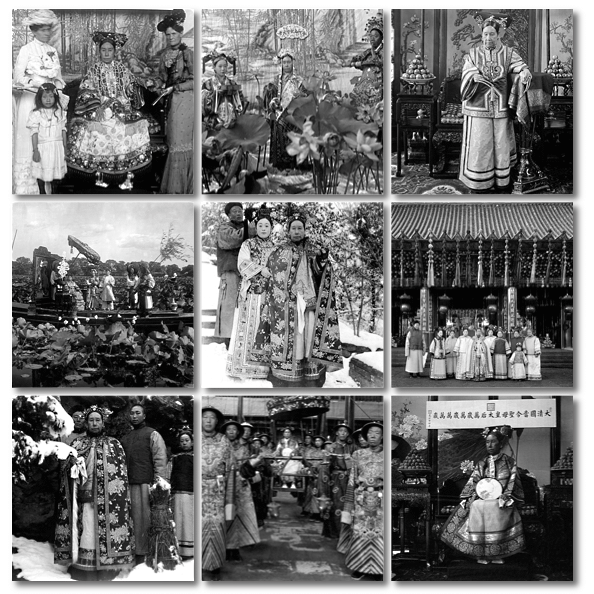 |
| |
Details from a selection of Xunling’s photographs of the Empress Dowager Cixi—regent of China for 47 years—show the types of poses, dress, and settings she wanted to present as her official image.
|
|
| |
The Empress Dowager & her Court Intimates
Imbued with a very feminine love of luxury, addicted to pleasure, and at one period of her life undoubtedly licentious after the manner of her Court’s traditions.… [1]
Tze-hsi [Cixi] cannot therefore be acquitted of a considerable amount of cruelty, of excessive ambition, of proneness to absurd superstition, of extravagance careless of the source whence it satisfied its needs, and of a pliancy of behavior perilously close to insincerity. [2]
In 1964, the Freer Gallery acquired 36 glass negatives from a Los Angeles dealer showing images of the Empress Dowager. No information was provided about their provenance except that they were from the estate of Princess Der Ling (Deling; 1885–1944), a writer who had achieved minor celebrity status in the United States as the author of a series of popular first-person accounts of her two years serving in the Empress Dowager’s court.
|
|
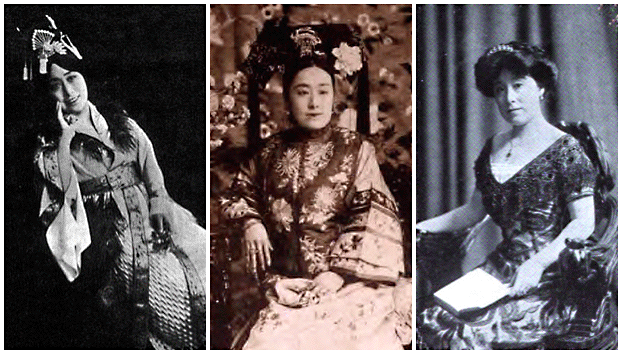 |
| |
Three photographs of Princess Der Ling, ca. 1911–1920
Der Ling, who was fluent in English, wrote about the Empress Dowager in her 1911 book, Two Years in the Forbidden City, featuring photographs of Cixi taken by Der Ling’s brother, Xunling.
Wikimedia [cx413] [cx412] [cx432]
|
|
  Der Ling’s books were strikingly illustrated with the photographs, which she claimed were taken by her brother Xunling (ca. 1880–1943), who had picked up photography as a hobby in Tokyo and then Paris, where their father was the Chinese ambassador. Der Ling’s books were strikingly illustrated with the photographs, which she claimed were taken by her brother Xunling (ca. 1880–1943), who had picked up photography as a hobby in Tokyo and then Paris, where their father was the Chinese ambassador.
While many scholars and China specialists were skeptical of Deling’s sensational accounts of life in Cixi’s court, the photographs of her at the side of the Empress Dowager at least corroborated the core of her story. |
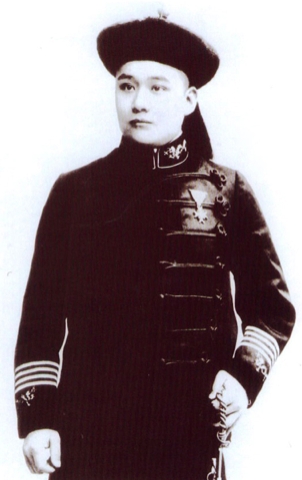 |
  right: Xunling, ca. 1900 right: Xunling, ca. 1900
Introduced to photography in Paris, Xunling was the photographer of the photographs of Cixi in this unit.
Wikimedia Commons [cx409] |
| |
 |
Der Ling “assisting Her Imperial Majesty, the Empress Dowager
of China, going down Peony Hill toward her Palace”
(caption in Der Ling’s 1911 book).
[cx115]
|
 |
| |
Xunling’s portraits have maintained a public presence, mostly as illustrations for newspapers and history books, epitomizing the reclusive luxury of the final years of imperial China—valued as historical artifacts, but with little attention given to their qualities as photographic art. While the bulk of Xunling’s original photographic prints remained in Beijing’s Forbidden City, the Freer negatives are a unique subset showing the raw originals prior to the heavy reworking required to turn them into a finished portrait.
|
|
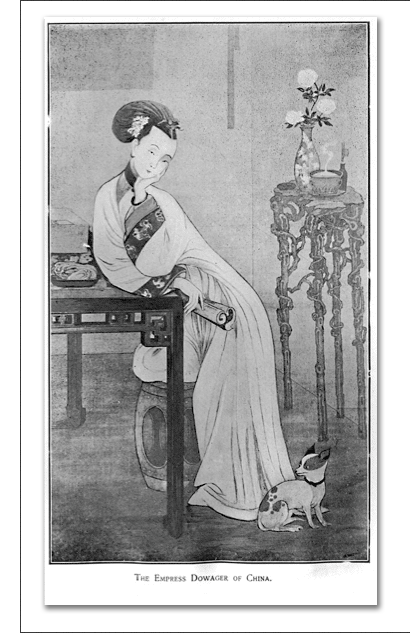 |
 |
While Cixi’s image abroad was largely that of a tyrannical “dragon lady,” this romanticized portrait said to be a depiction of her as a young woman also circulated in publications such as
Chinese
Characteristics by Arthur Smith (1894, 1st edition).
[cx224] |
 |
|
 |
| |
Born into the family of a mid-level Manchu official in or around 1835, Cixi entered the palace as a mid-level concubine in 1857. Her status rose dramatically in 1856 when she bore the Xianfeng Emperor’s only son. After Xianfeng’s death in 1861, Cixi became co-regent over her son the Tongzhi Emperor (1856–1875), along with the Empress Ci’an (1837–1881). Although women traditionally held little influence in China’s imperial court, the mother of an emperor or widow of a deceased emperor carried considerable authority to sway policy by forming personal alliances with the imperial princes. Cixi proved particularly adept at court politics and developed considerable influence, even after her son took direct authority upon his majority in 1873.
Following the Tongzhi Emperor’s premature death in 1876, Cixi amassed even greater power as regent to her three-year-old nephew, enthroned as the Guangxu Emperor (1871–1908). Cixi again stepped down when Guangxu was 17, but the conservative faction’s alarm at his modernization reforms of 1898 led to Cixi’s reinstatement as regent. Her position in the court remained unassailable until her death in 1908.
|
|
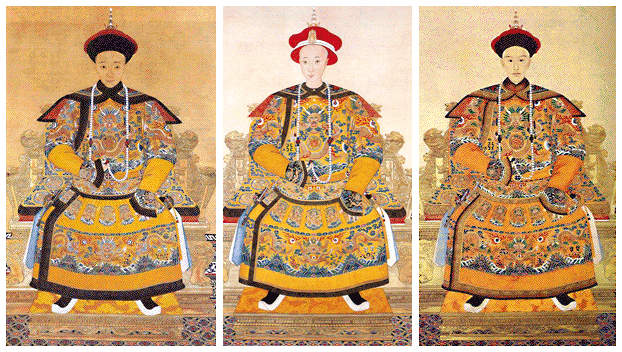 |
Traditional imperial portraits:
Cixi and the three emperors with
whom she was associated.
  above, left to right: above, left to right:
Xianfeng Emperor (1831–1861):
Cixi gained power as the mother
of his only heir.
[cx308]
Tongzhi Emperor (1856–1875):
Cixi’s son with the Xianfeng Emperor
became emperor at age five.
[cx307]
Guangxu Emperor (1871–1908):
Cixi’s nephew, whom she adopted so
that she could act as regent.
[cx306]
right: Imperial portrait of Cixi
[cx309]
Images: Wikimedia Commons |
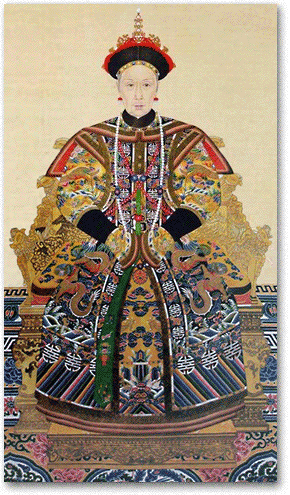 |
|
| |
Outside of the palace, China was suffering near continual disaster and decline, both economically and militarily. Rebellions had revealed the underlying vulnerability of Qing control, and repeated defeats by foreign military powers left the court weakened, saddled with crippling war indemnities, and tolerated by foreign military powers only for the sake of avoiding social breakdown and unrest. Cixi was personally condemned by the West for inciting the Boxers to attack foreign residents and Chinese Christians, and for standing in the way of China’s modernization. Restricted contact with foreigners increased the impression that the court was aloof, arrogant, and hostile to foreigners. |
|
  Cixi was personally condemned by the West for inciting the Boxers to attack foreign residents and Chinese Christians, and for standing in the way of China’s modernization.
A grotesque Cixi holding a bloody dagger dominates the cover of the French magazine Le Rire, July 14, 1900. The severed heads and mutilated bodies of Christians appear skewered in the background. Cixi was personally condemned by the West for inciting the Boxers to attack foreign residents and Chinese Christians, and for standing in the way of China’s modernization.
A grotesque Cixi holding a bloody dagger dominates the cover of the French magazine Le Rire, July 14, 1900. The severed heads and mutilated bodies of Christians appear skewered in the background.
[cx222]
|
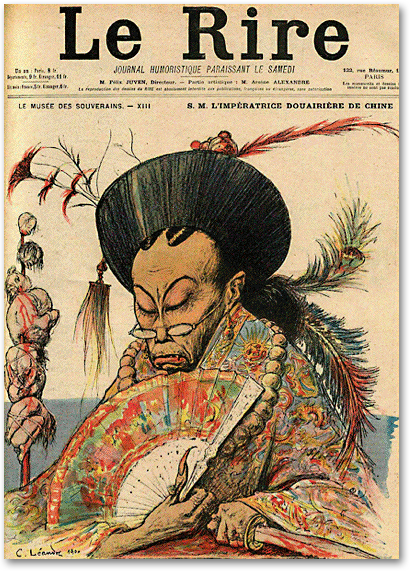
|
| |
Cixi’s Image Problem
China’s war with seven Western powers and Japan in the Boxer Uprising of 1900 contributed to severe image problems for the Empress Dowager abroad. In these graphics from France, Germany, Austria, and the United States, Cixi is portrayed as a bloated tyrant, a witch, an “empress” gloating over caged foreigners, and a murderess in a mug shot.
|
|
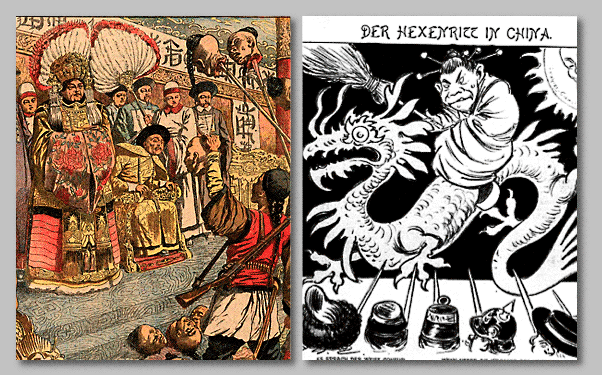 |
  “Nouveaux Massacres en Chine” “Nouveaux Massacres en Chine”
Le Petit Journal, March 6, 1904 (France)
caption: “L’Imperatrice douairiere presente a l’Empereur les tetes des mandarins accuses d’avoir favorise les interets russes.”
(The Empress Dowager has presented to the Emperor the heads of mandarins accused of favoring Russian interests.)
[cx215] |
|
  “Der Hexenritt in China” “Der Hexenritt in China”
(The Witch’s Ride in China)
Der Floh, 1900 (Germany)
caption: “It is said in the way of Confucius
about the rule of Tsu-tsie
If over the waters of the Yang-Tse-Kiang
The sun rises from Li-Hung-Chang,
Two dragons will drive you out of the country well
But a thousand devils come running.”
(click for the original text)
[cx228]  “Der Hexenritt in China” “Der Hexenritt in China”
(The Witch’s Ride in China)
Der Floh, 1900 (Germany)
caption: “Es sprach der Weise Confuci
ueber die Herrschaft der Tsu-Tsie
Wenn ueber die Waesser des Yang-Tse-Kiang
Die Sonne steigt von Li-hung-Tschang,
Dann treibt man Zwei Drachen wohl aus dem Land, Doch tausende teufel kommen gerannt.”
(click for an English translation)
[cx228] |
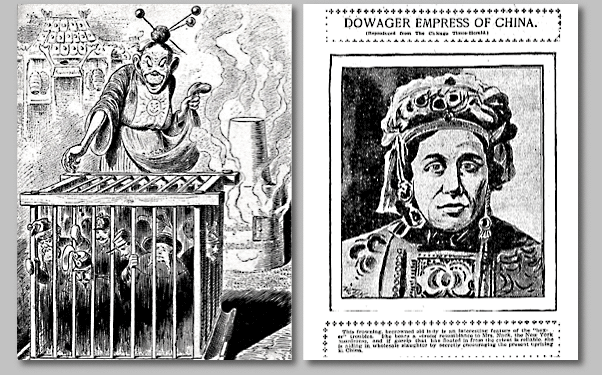 |
| |
Following the occupation of Beijing by the Eight Nation Alliance in 1900, foreign representatives demanded revisions to court protocols to allow unfettered access by diplomatic representatives. Because of the pressing need to accommodate the outside world, the court needed assistants adept at interaction with foreigners. A decision was made to enlist an extraordinary family headed by the diplomat Yugeng (d. 1905), a Manchu bannerman who had served as minister to Tokyo in 1895, and then to Paris in 1899. His wife, Louisa Pearson, was the daughter of a Han Chinese mother and an American businessman, and fluent in English. While overseas, their four children learned multiple languages and Western social graces.
|
|
  The Manchu diplomat Yugeng (seated at right) and family in Paris with the visiting Prince Zaifeng (seated, center) in 1901. The Manchu diplomat Yugeng (seated at right) and family in Paris with the visiting Prince Zaifeng (seated, center) in 1901.
Wikimedia Commons [cx405]
|
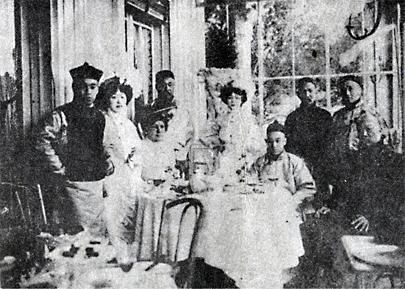 |
| |
The daughters Der Ling (Deling) and Rong Ling (Rongling, 1882–1973) in particular were immersed in modern Parisian culture, studying acting under Sarah Bernhardt and dance with Isadora Duncan. Unquestionably, this was a family capable of navigating the social complexities of visits by foreign diplomats and dignitaries. In early 1903, the family was summoned back to Beijing, and Louisa and her two daughters were brought to the New Summer Palace and retained as translators, advisors, and intermediaries.
|
|
| |
Cixi accompanied by Der Ling, Rong Ling, and their mother Louisa
Pearson in the gardens of the Yiheyuan (New Summer Palace).
detail [cx114]
|
|
| |
How Yugeng’s photographer son Xunling was introduced into the court is somewhat less clearly documented. Unlike his more-famous sisters, little is known about Xunling, aside from an essay written by Rongling’s daughter Lydia Dan when she visited the Freer Gallery in 1982:
Hsün-ling (Xunling) acted as his father’s private secretary and took up photography as a hobby while in Japan. He was not an ambitious man; the eldest of two boys and two girls, he was content with whatever fate dealt him, unassuming. The family looked upon him as being stupid. He was married at the age of 15, had a daughter and a son. [4]
By most accounts, the photo sessions were conceived by Cixi, perhaps in response to her awareness of photographic portraits of other imperial figures such as Queen Victoria and the Czar and Czarina of Russia. According to Der Ling, Cixi realized that it would be impossible to bring in a professional photographer:
My mother thereupon explained to Her Majesty that if she desired to have her photograph taken, one of my brothers, who had studied photography for some considerable time, would be able to do all that was necessary. [5]
Xunling was summoned to the New Summer Palace with his cameras and darkroom equipment. A studio was set up in the courtyard of Leshoutang, the main residence hall, and a makeshift throne room assembled. Special permission was required for Xunling to be seated in the Imperial presence in order to see through the lens, and his near-sightedness required permission for him to wear glasses in order to focus. Amusing anecdotes aside, high resolution scans of Xunling’s negatives do reveal some limitation in eyesight: focal points are often erratic at best.
|
|
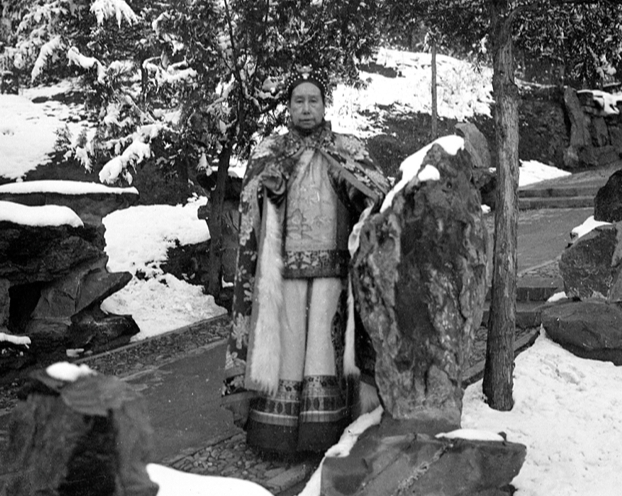 |
| |
An informal portrait in the garden of Yiheyuan.
detail [cx116]
|
|
| |
Without question, Xunling was an amateur photographer with limited technical skills. Yet in spite of his limitations, the images are compelling. While some commentators call Xunling China’s first art photographer, it may be a stretch to ascribe artistry to an amateur photographer with such a limited, anomalous portfolio; yet there is undeniably a majestic quality to many of the photographs that transcends Xunling’s abilities, probably due to Cixi’s own artistic engagement in the process.
Cixi was fascinated with the technology, and actively dictated the choice and placement of figures, costumes, and props. Cixi’s love of bold, sumptuous patterns and her passion for Chinese theater are strongly suggested in the densely crowded compositions of the photographs, filled with riotous patterns of lotuses, brocades, fruit, plants, and decorative screens, in contrast to traditional Chinese studio portraits with their spare use of conventional props.
|
|
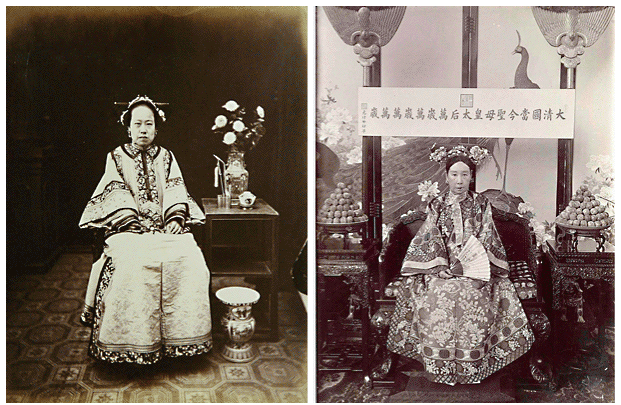 |
Traditional Chinese portrait
[cx201]
|
Cixi’s official portrait for diplomatic visitors
[cx202]
|
| |
Cixi’s love of rich decorative elements and theatrical settings are in sharp contrast to traditional Chinese studio photographs (left) with their spare use
of props.
|
|
| |
In this sense, the creative relationship of Cixi and Xunling is unique in the history of Chinese portrait photography, combining the photographer’s technical training with the subject’s own emphatic aesthetic vision. Almost immediately following their production, the photographs made their way into public view, reprinted in the press.
It is not clear whether Cixi or her court were complicit in the release of these images. What is clear is that the photographs were used as gifts to officials and as diplomatic exchange. The Qing court recognized that photographic portraiture could be an effective tool to rehabilitate Cixi’s damaged image, by conveying specific perceptions of imperial authority, religious piety, and moral refinement. In sum, the photographs hint at complex and multi-layered intentions: as Cixi’s personal exercise in creative self-representation, as a strategic response to the Qing court’s damaged public reputation, and as part of a program to develop international support through personal diplomacy. |
|
| |
Model Rulers
There is no hard and fast evidence that, in refurbishing her image after the Boxer Uprising, Cixi was directly influenced by photographs of Western royalty. Still, in her famous memoir Two Years in the Forbidden City, Princess Der Ling suggests that the Empress Dowager did indeed model her new self to some degree on Queen Victoria, who died in 1901. It is Victoria who is usually credited with popularizing royal portrait photography and, as the following two images suggest, the similarity between her official portraits and Cixi’s (taken in 1903 or 1904) is unmistakable. Victoria, 16 years older than Cixi, was photographed early and extensively during her 68-year reign, the first known photograph of her being taken in 1844. |
|
Queen Victoria as photographed for
her Diamond Jubilee, 1897.
[cx315]
|
Cixi's 1903–04 portrait
[cx110]
|
|



